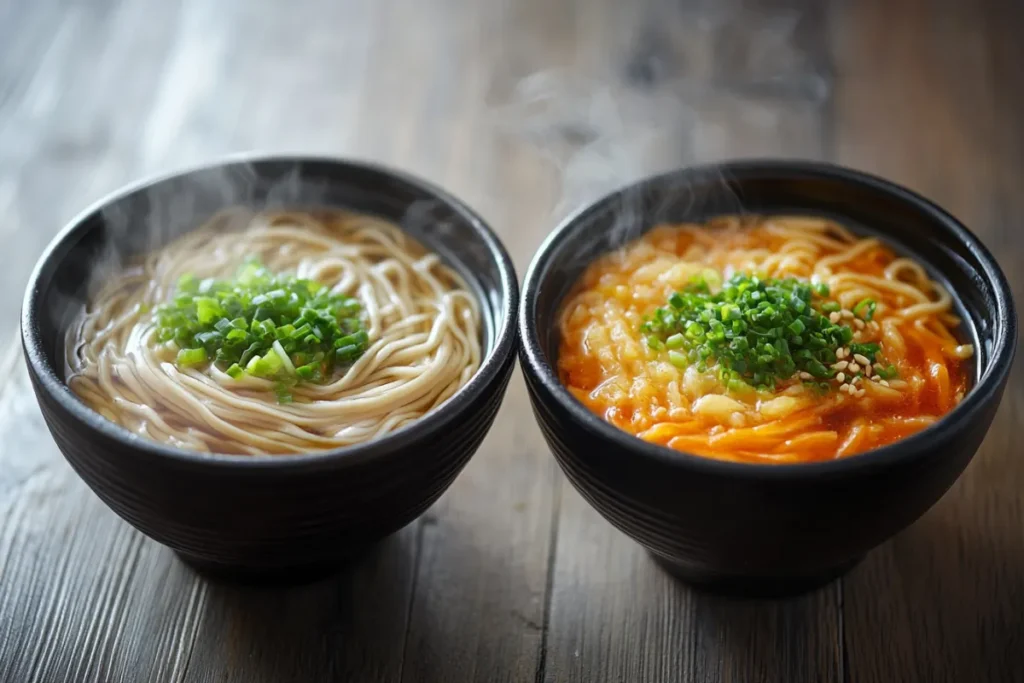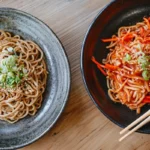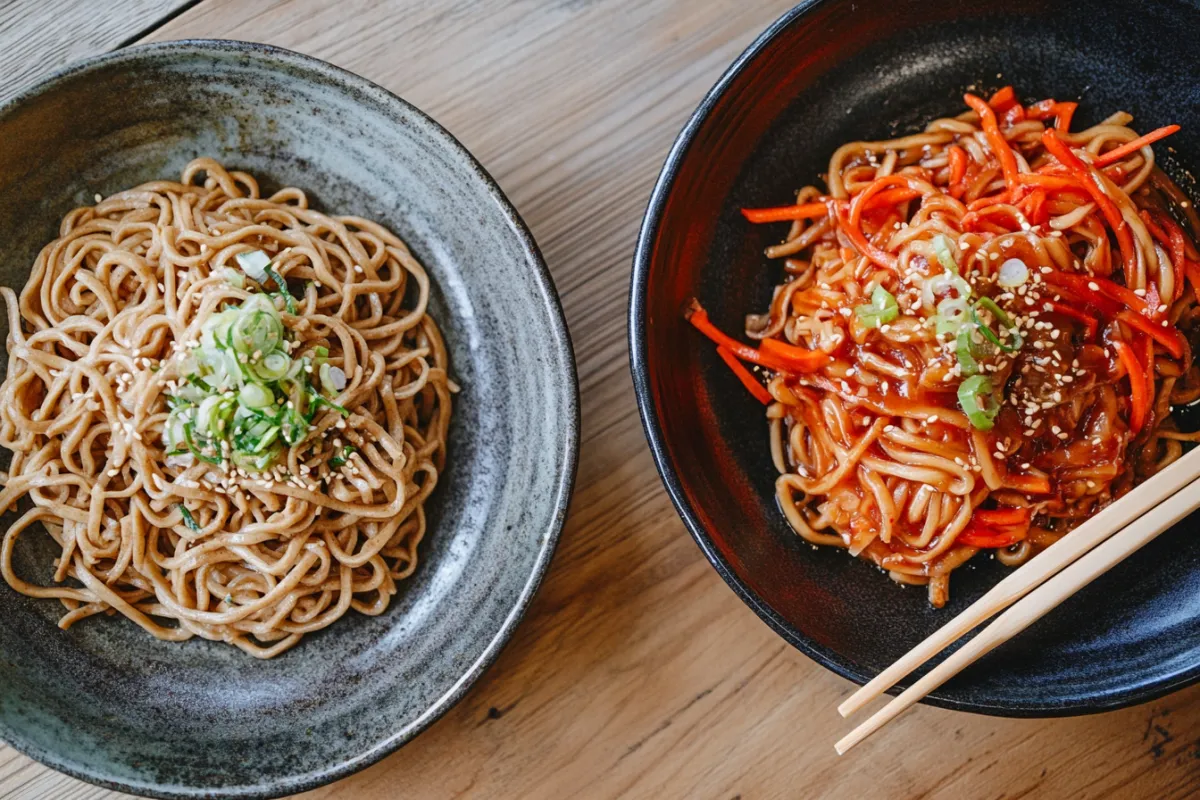Japanese cuisine is famous for its variety of delicious noodles, but many people often confuse soba with yakisoba. Are they the same? This article explores these two popular noodles, highlighting their unique characteristics, origins, and uses. By the end, you’ll understand what sets soba and yakisoba apart and why each deserves a place in your kitchen.
What is Soba? Understanding This Iconic Japanese Noodle
Soba noodles are a beloved part of Japanese cuisine. They are made mainly from buckwheat flour, which gives them a nutty flavor and distinct texture. These thin, brown noodles can be served hot or cold, and people often enjoy them in soups, salads, or with a light dipping sauce. The most popular types of soba include:
- Zaru Soba: Cold noodles served with a dipping sauce, often topped with seaweed strips for extra flavor and texture. This simple dish emphasizes the natural taste of soba, making it perfect for summer.
- Kake Soba: Hot soba served in a light broth with toppings like green onions, fish cakes, or tempura. It provides a comforting meal, especially in winter.
- Tempura Soba: Soba paired with crispy tempura vegetables or seafood, offering a satisfying mix of textures.
Soba’s buckwheat base not only gives it a unique taste but also makes it high in fiber, rich in protein, and gluten-free, which is excellent for those with dietary restrictions. Additionally, buckwheat contains antioxidants that support good circulation.
What is Yakisoba? The Stir-Fried Noodle Delight
Although they share part of the name, yakisoba is quite different from soba. Unlike soba, which uses buckwheat, yakisoba noodles are made from wheat flour, similar to ramen noodles. This noodle dish is stir-fried with vegetables, meat, or seafood and flavored with a sweet and savory sauce that often includes soy sauce, Worcestershire sauce, and other seasonings. Known for its rich taste, yakisoba is popular as comfort food, especially at festivals and street stalls.
Popular types of yakisoba include:
- Kawasaki Yakisoba: Recognized for its special local flavors and unique toppings, which vary by region.
- Vegetarian Yakisoba: Stir-fried with seasonal vegetables like cabbage, bell peppers, and carrots, offering a colorful and healthy option.
- Seafood Yakisoba: Enhanced with shrimp, squid, or other seafood, adding a tasty briny element that elevates the overall flavor.
Historical Background of Soba and Yakisoba
Soba has deep roots in Japanese history, dating back to the Edo period when it was popular among Samurai and everyday people alike. Its high levels of protein and fiber made it a nutritious choice. Soba first gained popularity in tea houses, and its easy preparation and distinct taste soon made it a favorite across Japan.
On the other hand, yakisoba emerged later, evolving from Chinese-style stir-fried noodles. It became a beloved street food in Japan in the early 20th century when locals adapted it to Japanese tastes with unique seasonings. Today, yakisoba is a staple at festivals, street fairs, and in home kitchens, celebrated for its versatile and rich flavor.
Soba vs. Yakisoba: Key Differences

When comparing soba and yakisoba, several key differences become clear. Soba is made primarily from buckwheat flour, giving it a nutty, earthy flavor and a firm texture, whereas yakisoba is made from wheat flour and stir-fried with vegetables, meat, or seafood. The two noodles not only differ in ingredients but also in their preparation and overall flavor profiles. Soba is typically boiled and served hot or cold, often highlighting its delicate taste in lighter dishes, while yakisoba’s bold, savory, and slightly sweet flavor makes it a popular choice for street food and comfort meals. Understanding these differences allows you to appreciate the unique qualities of each noodle.
- Ingredients: Soba uses buckwheat flour, while yakisoba uses wheat flour. This difference in ingredients changes their texture and taste.
- Cooking Methods: Soba is usually boiled and served hot or cold, highlighting its delicate flavors. In contrast, yakisoba is stir-fried, giving it a slightly crispy texture and caramelized taste.
- Texture and Flavor: Soba has a nutty, earthy flavor with a firm yet chewy texture. Yakisoba offers a savory, often sweet taste due to its special sauce, with a softer texture that absorbs stir-fry flavors.
- Nutritional Value: Soba is high in fiber and can be gluten-free, making it a healthier option. Yakisoba, while delicious, tends to have more sodium and calories because of the sauces and frying process.
These differences are not only culinary but also reflect their unique cultural contexts. Soba’s light and simple style contrasts sharply with yakisoba’s rich, street food appeal.
How Soba and Yakisoba Are Served
Soba noodles are versatile and can be served in various ways:
- Cold: Served as Zaru Soba, cold soba is a refreshing, light meal, perfect for warm weather. It is usually accompanied by a dipping sauce made from soy sauce, mirin, and dashi.
- Hot: Kake Soba provides a warm, comforting dish, especially during winter. The light broth allows the soba’s flavor to stand out.
- With Tempura: Tempura soba pairs the noodles with crispy tempura, creating a delightful combination of textures.
Yakisoba, on the other hand, is almost always served hot. It is stir-fried with vegetables, proteins, and a rich sauce. It’s a popular dish at festivals and food stalls, often topped with pickled ginger, dried seaweed, and sesame seeds. Some versions include a fried egg on top, adding an extra layer of flavor.
Flavor Profiles: How Do They Taste?

The taste profiles of soba and yakisoba highlight their differences:
- Soba: Offers a nutty, slightly earthy flavor thanks to the buckwheat flour. It works well in simple dishes that highlight its natural taste. Soba’s subtle flavor pairs nicely with light broths and dipping sauces.
- Yakisoba: Delivers a bold, savory, and slightly sweet taste from the sauce, making every bite rich and satisfying. The sauce combines sweet and tangy ingredients, providing a delicious contrast to the stir-fried noodles and vegetables.
Both noodles bring unique flavors to the table, making them suited to different dishes. Soba excels in light, refreshing meals, while yakisoba is perfect for hearty, flavorful dishes.
Health Benefits and Nutritional Differences
When deciding between soba and yakisoba, think about their nutritional profiles:
- Soba:
- High in fiber and protein, supporting digestion and muscle health.
- Contains antioxidants like rutin, which improve circulation and reduce inflammation.
- Lower in calories compared to other noodles, making it a good choice for weight management.
- Naturally gluten-free if made entirely from buckwheat, suitable for those with gluten sensitivities.
- Yakisoba:
- A good source of carbohydrates, providing energy, especially for active people.
- Can be high in sodium due to the sauces, so it’s best enjoyed in moderation.
- Contains fats from stir-frying, adding to its calorie content.
For those seeking a healthier choice, soba often comes out on top with its high fiber, antioxidants, and lower calorie count. However, yakisoba’s vibrant flavors and versatility make it a delicious option for special occasions.
Culinary Uses and Pairings
Soba noodles often pair with simple, clean flavors that match their nutty taste. They are ideal in:
- Light soups and broths, where the soba absorbs delicate flavors.
- Cold salads with fresh vegetables and a light dressing, are perfect for a refreshing summer meal.
- Paired with tempura or grilled fish, adding richness without overpowering the noodles.
Yakisoba, with its bold flavors, pairs best with:
- Stir-fried vegetables like cabbage, carrots, and bell peppers, adding crunch and color.
- Meats such as chicken, beef, or seafood, providing a hearty base.
- Toppings like pickled ginger and mayonnaise, enhancing the overall taste.
Both noodles offer a wide range of pairing possibilities, allowing for creativity in the kitchen and ensuring there’s always a dish that matches your mood.
Cultural Significance and Popularity in Japan and Abroad
Soba holds cultural importance in Japan, especially as a traditional dish enjoyed on New Year’s Eve, symbolizing a long, healthy life. This tradition, known as Toshikoshi Soba, reflects the Japanese belief in starting the year with a clean slate and healthy choices. Soba is also a favorite in summer when served cold.
Yakisoba, meanwhile, is a beloved street food, often linked to festivals and gatherings. Its easy preparation and rich flavors have made it popular not just in Japan but also worldwide. Yakisoba’s adaptability means it fits many settings, from casual lunches to festive events.
Misconceptions About Soba and Yakisoba
Many people assume that soba and yakisoba are the same because of their names. However, it’s crucial to understand:
- In yakisoba, the word “soba” refers to noodles in general, not specifically buckwheat noodles. This small detail often leads to confusion.
- Soba’s health benefits contrast with yakisoba’s richer, saucier nature. Understanding these differences helps you make better dietary choices.
- Their cooking methods and ingredients set them apart, with soba focusing on simplicity and yakisoba embracing bold, rich flavors.
Recognizing these differences allows you to enjoy each noodle’s unique qualities and appreciate them in their best culinary settings.
FAQs (Frequently Asked Questions)
1. Are soba and yakisoba the same?
No, soba and yakisoba are different. Soba uses buckwheat flour, while yakisoba uses wheat flour and is stir-fried. Their ingredients, cooking methods, and flavors set them apart.
2. Which is healthier: soba or yakisoba?
Soba is generally healthier due to its high fiber and lower calorie content. Yakisoba often has higher sodium and fat because of the sauces used.
3. Can you substitute soba for yakisoba in recipes?
You can substitute them in some recipes, but their flavors and textures will differ. Soba works best in lighter dishes, while yakisoba suits stir-fries with bold flavors.
4. What are the best toppings for soba and yakisoba?
Soba pairs well with green onions, seaweed, and tempura flakes. Yakisoba often comes topped with pickled ginger and dried seaweed for added flavor.
5. Is yakisoba gluten-free?
No, yakisoba uses wheat flour, making it unsuitable for a gluten-free diet. Soba can be a good gluten-free option if made entirely from buckwheat flour.
Conclusion
Soba and yakisoba may share part of their names, but they are distinct noodles with unique flavors, uses, and nutritional profiles. Soba offers a nutty, healthful option ideal for simple dishes, while yakisoba provides a richer, saucier experience perfect for stir-fries and street food enthusiasts. Understanding the differences between soba and yakisoba allows you to appreciate each one’s special qualities.
Whether you opt for soba’s light touch or yakisoba’s bold bite, both bring a taste of Japan to your table. Explore their unique flavors, and you’ll soon find each has a place in your culinary adventures.
Print
Soba vs Yakisoba: Understanding Japanese Noodles
- Total Time: 45 minutes
- Yield: 4 servings
- Diet: Gluten-Free (for soba only)
Description
Explore the differences between soba and yakisoba, two popular types of Japanese noodles, and learn how to enjoy them in various dishes.
Ingredients
- Soba noodles (buckwheat flour)
- Yakisoba noodles (wheat flour)
- Dipping sauce for zaru soba (soy sauce, mirin, dashi)
- Broth for kake soba (light broth)
- Seasonal vegetables (cabbage, bell peppers, carrots)
- Tempura (vegetables or seafood)
- Protein options (chicken, beef, seafood)
- Pickled ginger
- Dried seaweed
- Sesame seeds
Instructions
- Prepare soba according to package instructions. For zaru soba, serve cold with a dipping sauce. For kake soba, serve hot in a light broth.
- Cook yakisoba noodles in a pan and add a mix of vegetables and proteins, stir-fried with sauces until heated through.
- For tempura soba, prepare tempura while cooking soba, then serve soba topped with tempura.
- Garnish dishes with pickled ginger and dried seaweed for yakisoba.
Notes
Soba can be served hot or cold, while yakisoba is best enjoyed hot. Explore different toppings to enhance flavors.
- Prep Time: 15 minutes
- Cook Time: 30 minutes
- Category: Main Course
- Method: Stir-Frying and Boiling
- Cuisine: Japanese
Nutrition
- Serving Size: 1 serving
- Calories: 450
- Sugar: 6g
- Sodium: 600mg
- Fat: 15g
- Saturated Fat: 3g
- Unsaturated Fat: 7g
- Trans Fat: 0g
- Carbohydrates: 62g
- Fiber: 5g
- Protein: 18g
- Cholesterol: 40mg
Keywords: Soba, Yakisoba, Japanese noodles, Healthy noodles, Street food

